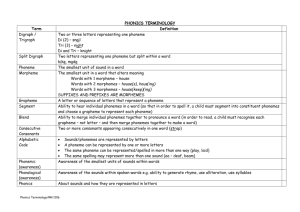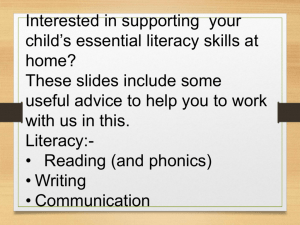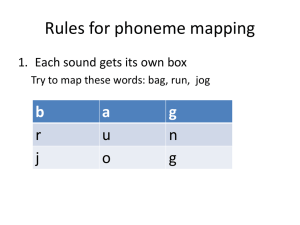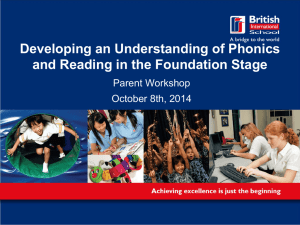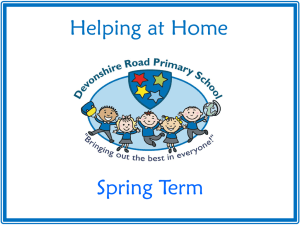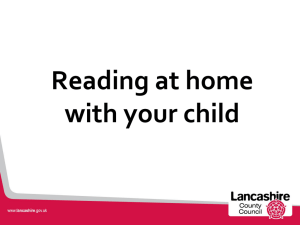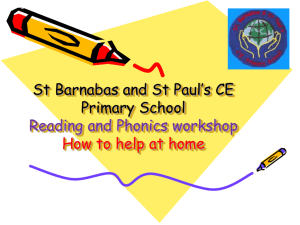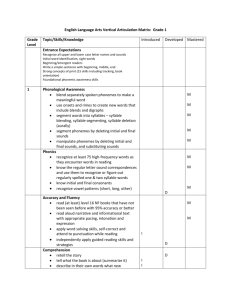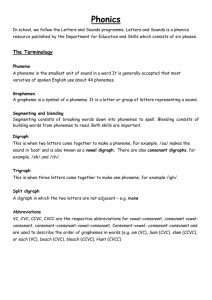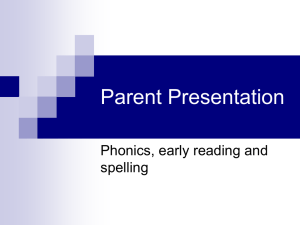PhonicsParentsInformationEvening
advertisement
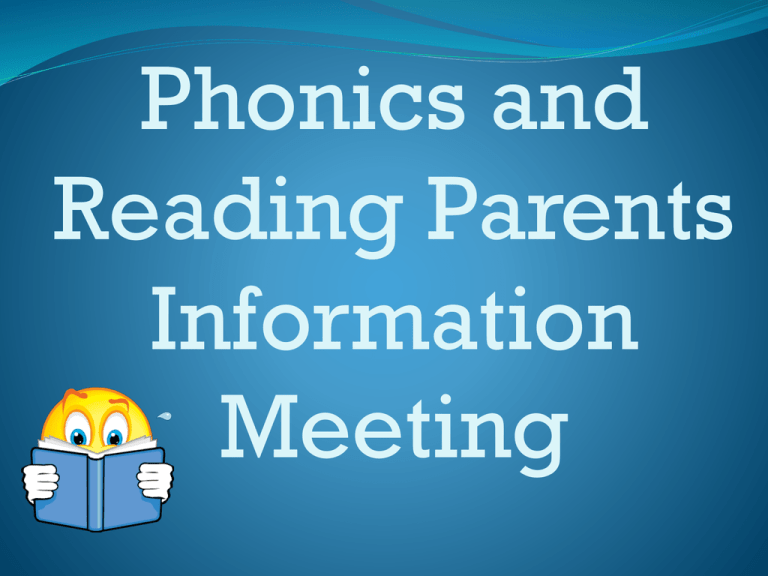
Phonics and Reading Parents Information Meeting The English Language 26 letters of the alphabet 44 sounds 140 ways to spell these sounds The Alphabetic Code Phoneme The smallest unit of sound in a word. There are 44 phonemes that we teach. The 44 phonemes /b/ /d/ /f/ /g/ /h/ /j/ /k/ /l/ /m/ /n/ /ng/ /p/ /r/ /s/ /t/ /v/ /w/ /y/ /z/ /th/ /th/ /ch/ /sh/ /zh/ /a/ /e/ /i/ /o/ /u/ /ae/ /ee/ /ie/ /oe/ /ue/ /oo/ /ar/ /ur/ /au/ /er/ /ow/ /oi/ /air/ /ear/ /ure/ Grapheme • Letters representing a phoneme • A grapheme may consist of one (t), two (ch), or more letters (igh). • A phoneme can be represented in more than one way: cat, kennel, choir • The same grapheme may represent more than one phoneme: circus, car, me, met Blending • Children need to be able to hear the separate sounds in a word and then blend them together to say the whole word . c / a / t sh / ee / p cat sheep Segmenting Chopping up a word to spell it out How many phonemes in these words? dog light speech dog = 3 - d / o / g light = 3 - l / igh / t speech = 4 - s / p / ee / ch Other Terminology Digraph (2 letters 1 sound) Consonant digraph (sh, ch, ck, th, ll, ss) Vowel digraph (at least 1 vowel – ee, ai, ar, er) Trigraph (3 letters 1 sound igh, dge,) Split digraph/sometimes magic e but we teach correct terminology (bike, came, rose) High Frequency Words/ Tricky Words There are 100 high frequency words in Phases 1- 5. There are 200 common words. High frequency words become decodable as children develop their phonic knowledge e.g. ‘dad’ in Phase 2. Tricky words are words children need to learn that will help them read more fluently e.g. was, the, people. At Shaw-cum-Donnington we use Letters and Sounds as our main phonics scheme and we supplement this with other resources. There are 6 Phases taught through Early Years and Key Stage One Phase 1 •Environmental sounds •Instrumental sounds •Body percussion •Rhythm and Rhyme •Alliteration •Voice sounds •Oral blending and segmenting Phase 2 Introduces letter sound correspondences Set 1: s a t p Set 2: i n m d Set 3: g o c k Set 4: ck e u r Set 5: h b f ff l ll ss Blend and segment vc, cv, cvc words Read high frequency words: is it in at and to the no go I Phase 3 Set 6: j v w x Set 7: y z zz qu Set 8: ch sh th ng Also: ai ee igh oa oo ar or ur ow oi ear air ure er Phase 3 - continued Read high frequency words he she we me be was my you they her all are Spell no go the to I Read and spell 2 syllable words and captions Letter names Phase 4 Blending and segmenting adjacent consonants for reading and writing 2 syllable words: lunchbox, desktop etc. cvc, ccvc, cvcc words Phase 5 Further graphemes for reading ay ou ie ea oy ir ue aw wh ph ew oe au a-e i-e e-e o-e u-e Alternative pronunciations for graphemes (fin, find cow, blow) High frequency words (read and spell) Alternative spellings for phonemes ( sh tion ss cion ch) Read and spell 2 syllable and 3 syllable words Writing and reading sentences Phase 6 Spelling focus Past tense (ed) Suffixes (s es ing ed er est ful ly y ment ness) Prefixes Plurals Spelling long words Finding and learning the difficult bits in words Learning and practising spellings (syllables, base words, analogy, mnemonics) Application of spelling in writing Reading at school and home Reading • Success in reading is fundamental to success in school. • Reading is all about acquiring meaning; for enjoyment, information and understanding. • It is not a performance. • It is not a test. Every time you finish a book - do always choose a harder one next time? Understanding (Comprehension) • Being able to read does not mean you understand what you read. • Your child might sound like a good reader but may not necessarily understand what the text means. • The best way to develop understanding is to talk about texts. • The next slide is easy to read – does anyone understand what it means? An extract taken from a computer manual According to the previous ATA/IDE hard drive transfer protocol, the signalling way to send data was in synchronous strobe mode by using the rising edge of the strobe signal. The faster strobe rate increases EMI, which cannot be eliminated by the standard 40pin cable used by ATA and ultra ATA. Reading requires two skills Phonics and Word Recognition The ability to recognise words presented in and out of context. The ability to blend letter sounds (phonemes) together to read words. Understanding The ability to understand the meaning of the words and sentences in a text. The ability to understand the ideas, information and themes in a text. If a child understands what they hear, they will understand the same information when they Reading in School The Teaching of Reading • • • • • • Phonics – daily Shared reading (being read a story) - daily Guided reading – once a week KS1 Independent reading - daily Reading across the curriculum – daily 1:1 reading with an adult (teacher/teaching assistant/parent helper) – as often as possible The hearing of reading is NOT the teaching of reading Home reading books and records Books are set in book bands In each band there are different sets of books – some more difficult than others. In each band our books are organised so they get progressively more difficult. This could be because of type (fiction/ non-fiction) or use of high frequency words (words that can’t be sounded out). When they move book bands the first ones are usually easier to read. The children only move a book band when listened to by a teacher. What to do if your child is stuck Use phonics first. What sound does the word begin with? Can you say the sounds in the word? Blend them together. Read to the end of the sentence. What would make sense? What is the text about – what might fit here? Does it sound right? Look at the picture. Does it help? Home reading records • Please sign to say when you have listened to them read. We also initial books when any adult in school has listened to them. • Comments we find helpful – We took it in turn to read, good expression, we discussed what might happen next, we looked for capital letters and full stops, clear reading, could tell me the meaning of difficult word. ‘My child read this book easily’ Sometimes we try not to move children on too quickly - To boost their confidence in reading - Reluctant readers at home - Can read the book fluently but they do not understand all the vocabulary Changing reading books • In Class 4 (Reception) – when they have read to a teacher or teaching assistant. • In Class 3 (KS1) – when they have read to an adult at home and sometimes if they have read in school • Children will ideally read each book twice with the earlier book bands. • Teachers or teaching assistants can only change books – ideally this is 2 or 3 times a week. Reading at Home – enjoy! Make reading visible; have books available in your home. Share books every day. Boys need to see that reading is something men do. Talk about books. Sit and listen - don’t do chores around the reader! Respect choices. Reading to your children • Introduce your children to different types of books; • • • • classic fiction, chapter books, short stories, joke books, poetry, non-fiction. Read them the book that was your favourite when you were a child. Read slowly, with expression. Try to use different and funny voices for characters. Follow the words and read the story using the pictures. Talk about what is happening and what might happen next. Leave the story on a cliffhanger! Useful sites http://www.phonicsplay.co.uk/ http://www.bbc.co.uk/cbeebies/alphabloc ks/ https://content.espresso.co.uk/openhive http://www.oxfordowl.co.uk/
